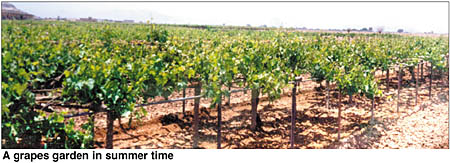
Growing grape in Yemen, highly food yield [Archives:2002/35/Business & Economy]
August 26 2002

BY MAHYOUB AL-KAMALI
YEMEN TIMES STAFF
Grape growing in Yemen is has a good reputation in Yemen and as a nutritive fruit tree it has become grown in special orchards and house gardens, especially in the capital Sana’a.
Yemeni grape has various colors, sizes and tastes and called by different names after its various types. As a fruit, the taste of grape differs according to the kind of soil it is grown in and the element of climate.
Rowing grape as crop in Yemen has expanded substantially and the best of its types are exported to foreign markets. The grape tree growing occupies an area of arable land amounting to 22 thousand hectares, i.e. around 35% of land cultivated with fruits. Yemen’s average production of grape totals 135 thousand a year, equal to 37% of total fruits production.
Sana’a comes in the first place in grape production scoring 80% of total production and that is due to its climate and suitable soil. In the second place comes the governorate of Sa’ada in the North of Yemen as it produces 10% of gross production, while other areas yield the remainder proportion.
As a crop, grape brings upon farmers big amounts of revenue. Statistics indicate that the gross income of fresh and dried grape amounts to over YR 7 billion, YR 6,21§5 billion for fresh grape and over YR 862 million for dried grape.
Yemeni grape has many categories, most famous of which are the Baydah, Raziqi, al-A’simi, al-Aswad ( dark purplish red) and al-Jabri and others that are of high economic feasibility. Yemeni grape tree is characterized by abundant yield.
Grape marketing
Marketing grape production to local markets is carried out with traditional means owing to weakness of methods for preserving the grape fruit in refrigerators to prevent its decay and keep it on market for a long period. Nevertheless, large quantities of grape are exported to external markets, especially the good qualities to ensure hard currency revenues. Grape cultivation is exposed to being infected with some kinds of diseases caused by some kinds of insects. Therefore the department of crop preservation at the ministry of agriculture has implemented a large-scale campaign for fighting such diseases and it has covered an area of 571,625 square hectares in various areas where grape is grown. The campaign has succeeded in increasing the volume of production in the areas included by the campaign by 154 million kilograms of fresh and dried grape.
Yemeni grape cultivation which is not used in making wines, needs, however, a marketing policy especially to external markets by larger quantities because the volume of local consumption is not able to take in the total production.
Grape cultivation and its extension is, on the other hand, considered a necessary alternative to uproot the qat non-nutritive tree.
——
[archive-e:35-v:2002-y:2002-d:2002-08-26-p:./2002/iss35/b&e.htm]


